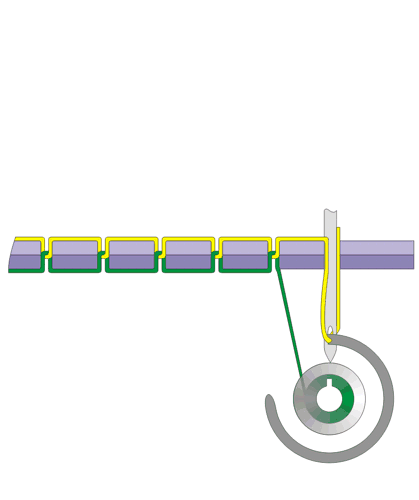How a Sewing Machine Works
Today I found out how a sewing machine works.
Modern day sewing machines typically use something called “lock stitch”; in older machines a “chain stitch” was fairly popular, but is generally no longer used due to the fact that it pulls out very easily. A lock stitch on the other hand is quite strong and is created by using two separate threads that interlock with one another through a layer of fabric.
Rather than try to describe it in more detail with words, it’s much simpler just to look at the amazing animation below (warning: side effects of viewing the below animation may include mesmerization, vacant expression, loss of several minutes of your life, and slight drooling):

Bonus Facts:
- The chain stitch is still often used for sewing up pet food bags; this allows you to easily open the bag by pulling the stitch out starting from one end and pulling until the whole thing comes out.
- British inventor Thomas Saint was the first to patent a design for a sewing machine. However, he never actually built this machine. More recently, sewing machine enthusiasts have built the machine outlined in the patent and were forced to make significant changes in order to get it to work.
- An Austrian tailor, Josef Madersperger, in 1814 built the first working sewing machine.
- In 1830, a French tailor by the name of Barthelemy Thimonnier patented a sewing machine that used the chain stitch. By 1841 he had a factory with over 80 machines and a contract with the French army for uniforms. However, the factory was destroyed by a riotous group of French tailors who were afraid the sewing machine would spell the end of their trade. Thimonnier never recovered and died pretty much penniless.
- By the 1850s in the United States, sewing machine companies had what is known as the “Sewing Machine War” where each company would patent some very slightly different sewing machine design which resulted in hundreds of lawsuits against one another. Eventually, Singer, Howe, Wheeler and Wilson, and Grover and Baker, some of the biggest sewing machine manufacturers of the day, joined forces pooling their collective patents and forced all other manufacturers to obtain a license and pay $15 per machine. This lasted until 1877 when the patents expired.
- The sewing needle for a sewing machine has six parts: shank, shaft, eye, point, groove, and scarf. How it works is the thread is placed in the groove and into the eye from the front. The scarf is in the back of the eye helps the bobbin shuttle to pick up the thread.
| Share the Knowledge! |
|





Yeah… it has amazed me since I was a kid, looking into the gutters of my mom’s sewing machine… she had a pedal operated Singer for quite some time.
Now my wife has a serger, which is also an amazing engineered thing with all those threads… the only complaint is that when it’s gets out of tune…..